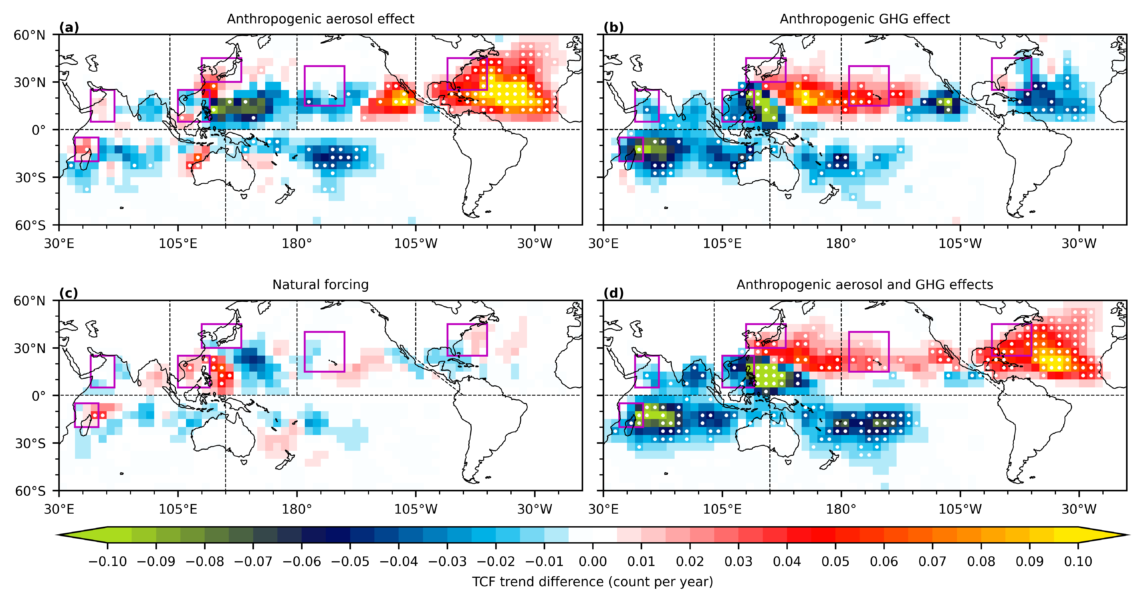November 17th, 2023
Key Findings
- A substantial impact of anthropogenic climate change on tropical cyclone frequency (TCF) may have emerged over heavily populated coastal regions.
- Observed increases in TCF since 1980 near the U.S. Atlantic coast and Hawaii are likely related to aerosol and greenhouse gas (GHG) effects, respectively. Increases near Japan and Korea during this period can be attributed to the combined effects of aerosols and GHGs. The observed decrease in the South China Sea is associated with GHG emissions alone.
- These changes in coastal TCF are explained by the responses of large-scale environmental conditions to anthropogenic forcing.
Shuai Wang, Hiroyuki Murakami, William F. Cooke. npj Climate and Atmospheric Science. DOI: 10.1038/s41612-023-00516-x
Anthropogenic activities have been affecting our climate since the industrial revolution. The effect of anthropogenic climate change on tropical cyclones (TCs) is of particular concern because of their catastrophic damage at landfall and their relatively frequent occurrence compared to other natural hazards. However, attributing a regionally observed change in tropical cyclone frequency (TCF) to anthropogenic climate change is notoriously challenging for two main reasons. First, climate internal variability can considerably modulate regional TC activities. Second, reliable TC observations are only available since the satellite era, and therefore, not long enough to separate the potential effect of anthropogenic climate change from climate internal variability.
Using GFDL’s SPEAR climate model, the authors produced large-ensemble simulations to show that the observed increases in TCF since 1980 near the U.S. Atlantic coast and Hawaii are likely related to aerosol and greenhouse gas (GHG) effects, respectively. The observed increases near Japan and Korea during this period are attributed to the combined effects of aerosols and GHGs. The observed decrease in the South China Sea after 1980 was associated with GHG emissions alone. These changes in coastal TC frequency are explained by the responses of large-scale environmental conditions to anthropogenic forcing.
This study reveals the potentially dominant role of anthropogenic forcing on coastal TCF changes around the US Atlantic coast, Hawaii region, Northeast Asian coast near Japan and Korea, South China Sea, western coast of the Arabian Sea, and Madagascar region with simulations, which echo the significant trends in TCF in observations.
Further analysis reveals that regional oceanic and atmospheric warming may be the primary cause of the coastal TCF changes under anthropogenic forcing. The anomalous lower-tropospheric warming at midlatitudes under the aerosol effect weakens the subtropical jet over the North Atlantic, which reduces vertical wind shear over the Atlantic Main Development Region, increases the cyclogenesis probability, and thus increases TC activity along the US Atlantic coast. Over Northeast Asia and the western North Pacific, aerosol and GHG effects can also generate lower-tropospheric warming at midlatitudes, weakening the subtropical jet, therefore increasing the chance for TCs approaching the Japan-Korea region.
The equatorial central Pacific warming under the GHG effect stimulates a classical Gill-type circulation pattern in the northern tropical Pacific, which could be related to the increase in TCF near Hawaii and a reduction in the South China Sea by varying the local TC steering and genesis conditions.
This study suggests that inhabited coastal regions worldwide may experience uneven changes, with increased landfalling TC threats in some areas and decreased threats in others, as anthropogenic climate change persists.



